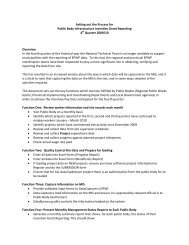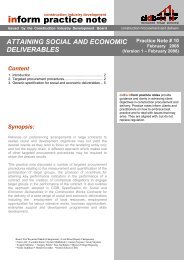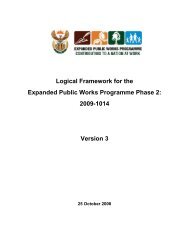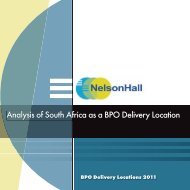Evaluation of the Monyetla Work Readiness ... - Business Trust
Evaluation of the Monyetla Work Readiness ... - Business Trust
Evaluation of the Monyetla Work Readiness ... - Business Trust
Create successful ePaper yourself
Turn your PDF publications into a flip-book with our unique Google optimized e-Paper software.
In order to avoid bottlenecks at <strong>the</strong> supervisor and manager level, <strong>the</strong> employers in <strong>the</strong> programme will berequired to provide supervisor, team leader or manager training in a ratio <strong>of</strong> 1:6. So, for every six entry-levellearners trained in <strong>the</strong> programme <strong>the</strong> employer will be required to undertake to train one supervisor, teamleader or manager.It may be possible to <strong>of</strong>fset <strong>the</strong> costs <strong>of</strong> team leader or manager training through <strong>the</strong> levy grant systemoperated by <strong>the</strong> relevant SETA. Employers should contact <strong>the</strong> relevant SETA to determine how this can bedone”.Seventy-eight percent <strong>of</strong> <strong>the</strong> training providers interviewed indicated that training methods forsupervisors were similar in inbound and outbound environment. But, 22% <strong>of</strong> <strong>the</strong> respondentsindicated that <strong>the</strong> training methods were different because most companies trained supervisors inhouse.They said that general leadership training is not just specific to call centres and it varies fromcompany to company depending on several variables, such as <strong>the</strong> size <strong>of</strong> <strong>the</strong> team size, <strong>the</strong> productor service and <strong>the</strong> nature <strong>of</strong> industry.In most <strong>of</strong> <strong>the</strong> cases, supervisors who were trained were linked to host employers. TeleTechhowever, trained some <strong>of</strong> its <strong>Monyetla</strong> learners for supervisory roles and achieved positive results.All consortia that completed <strong>the</strong> programme and closed out had ei<strong>the</strong>r met or exceeded <strong>the</strong>supervisor to learner training ratio <strong>of</strong> 1:6. Of <strong>the</strong> total 1,129 learners who completed, 368supervisors were trained - resulting in a supervisor to learner training ratio <strong>of</strong> 1:3.Much <strong>of</strong> <strong>the</strong> supervisor training was funded privately because employers indicated that <strong>the</strong>y <strong>the</strong>rewas no incentive to try to obtaining Seta funding because it was a lengthy process and in most cases<strong>the</strong> relevant SETAs had indicated that funding would be granted on a discretionary basis. But, about28% <strong>of</strong> consortia persevered and obtained funding from <strong>the</strong> relevant SETA.4.3.10 Fur<strong>the</strong>r TrainingA requirement stemming from objective 5 <strong>of</strong> <strong>the</strong> RFP was to encourage <strong>the</strong> development <strong>of</strong> entrylevelskills programmes into learnerships:Employers responding to this request should indicate how entry-level employees will be enabled to progressfrom <strong>the</strong> <strong>Monyetla</strong> entry-level skills programme to acquire <strong>the</strong> credits necessary to complete a learnership.Only three consortia ensured that learners received <strong>the</strong> full learnership, with <strong>the</strong> South African PostOffice consortium doing very well in this regard. It ensured that all <strong>the</strong> learners who had beenallocated to <strong>the</strong>m obtained <strong>the</strong> full learnership regardless <strong>of</strong> whe<strong>the</strong>r or not <strong>the</strong>y were employed by<strong>the</strong> post <strong>of</strong>fice. Consortia 3 and 15 also ensured that all <strong>the</strong> learners who had successfully completed<strong>the</strong> skills programme obtained <strong>the</strong> full learnership. One hundred and forty eight (148) <strong>of</strong> <strong>the</strong> learnersreceived a full learnership.An interesting observation is that Consortia 3 and 18, which provided <strong>the</strong> full learnership, had two<strong>of</strong> <strong>the</strong> lower placement rates in <strong>the</strong> programme, 73.5% and 70% respectively.This reflects <strong>the</strong> importance <strong>of</strong> ensuring placement while learners are still working through <strong>the</strong>programme because while some learners received a full learnership, it was still difficult for <strong>the</strong>m touse <strong>the</strong> full Level 2 learnership to obtain a job outside <strong>the</strong> <strong>Monyetla</strong> programme. Fur<strong>the</strong>r researchneeds to be conducted to test this preliminary observation. Learners with a full learnership who didnot manage to get a job within <strong>the</strong> <strong>Monyetla</strong> timeframes would have to be tracked and interviewedto ascertain if, and where <strong>the</strong>y were working, to assess <strong>the</strong> portability <strong>of</strong> <strong>the</strong> full Learnership.44
















